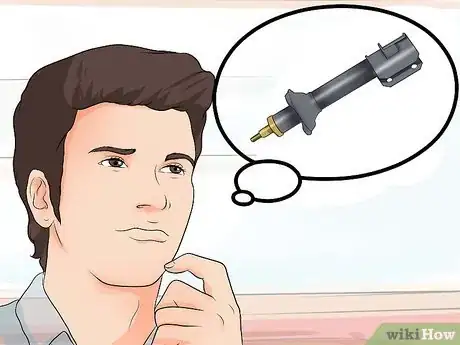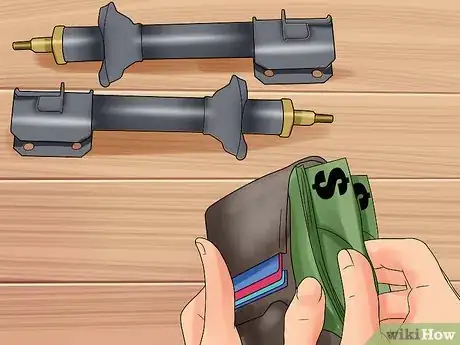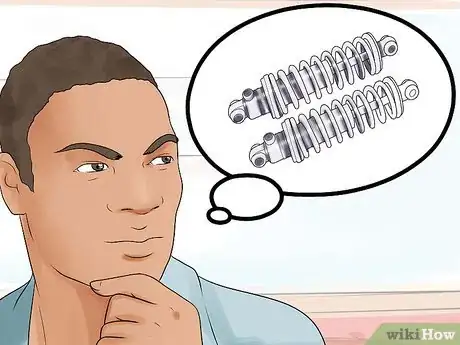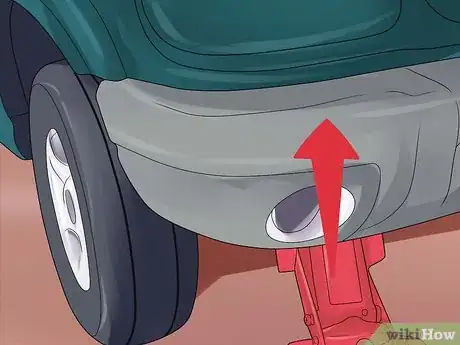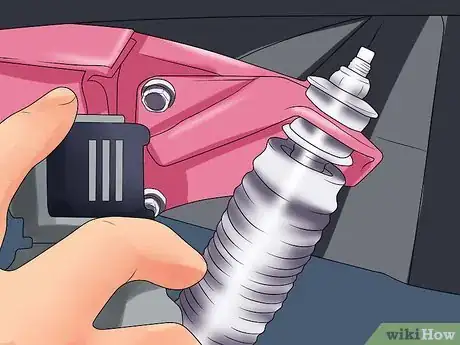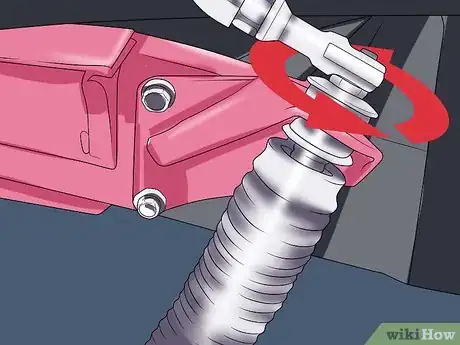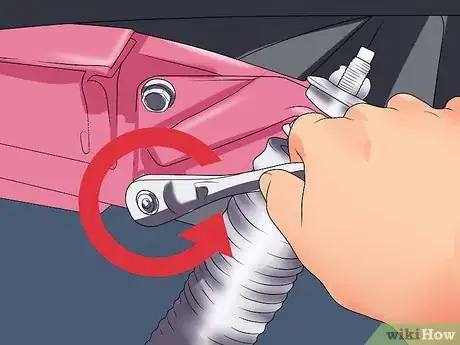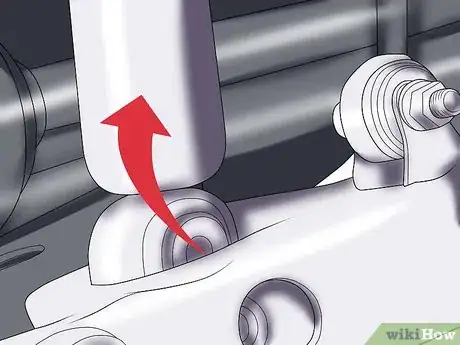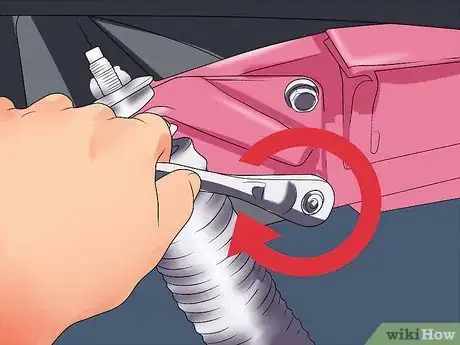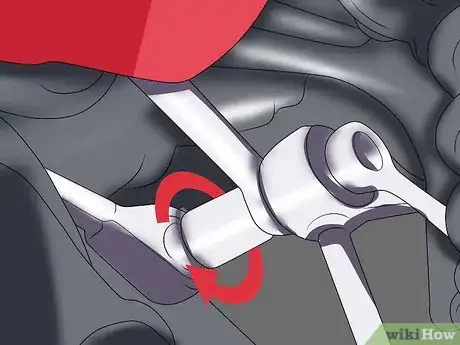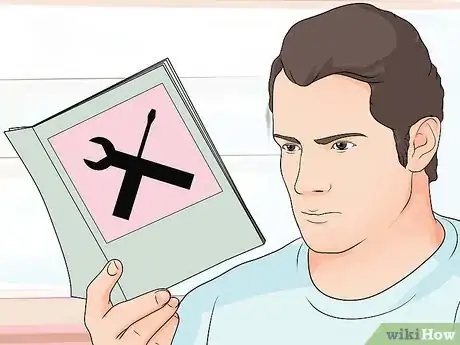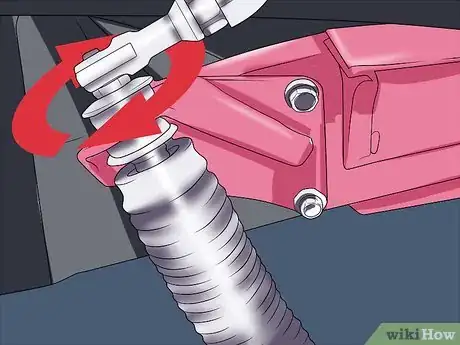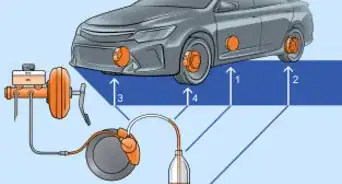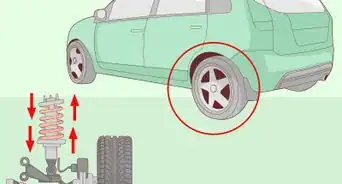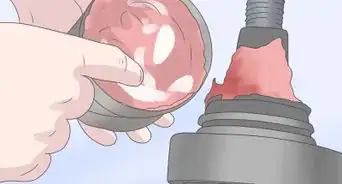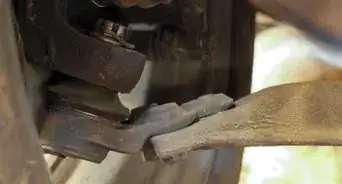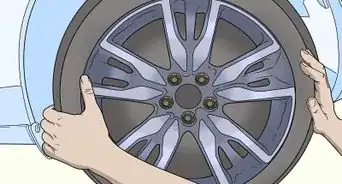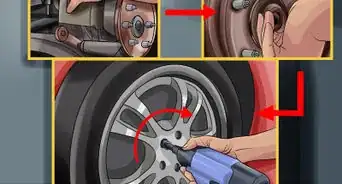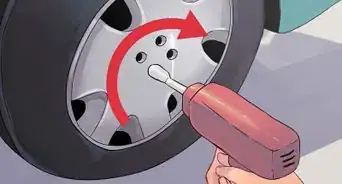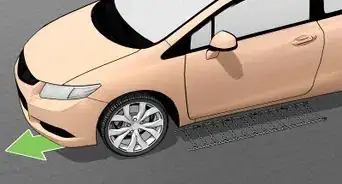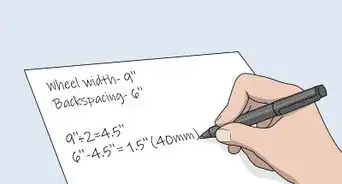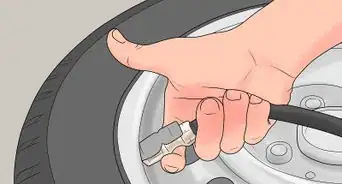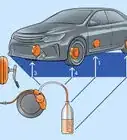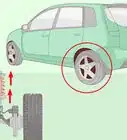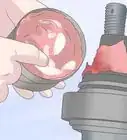This article was co-authored by Hovig Manouchekian. Hovig Manouchekian is an Auto Repair and Design Specialist and the Manager of Funk Brothers Auto, a family-owned business operated since 1925. With over 30 years of experience in the automotive industry, Hovig specializes in the process of auto repair and maintenance. He is also very knowledgeable in common automotive issues and needs including engine repair, battery replacement, and windshield accessory and maintenance. Hovig's knowledge and hard work have contributed to Funk Brothers Auto winning Angie's List Super Service Award for five consecutive years.
There are 10 references cited in this article, which can be found at the bottom of the page.
This article has been viewed 426,535 times.
If you need to replace your car's shock absorbers but don't want to pay an expensive mechanic's fee, you can do so on your own with a little effort. Shocks are essential to a car's performance, giving it a smooth and even ride. Over time, however, the vehicle's suspensions become worn out. You may notice potholes and speed bumps are more severe and uncomfortable to drive over. In this case, you'll want to replace your shocks, which you can do at home in an afternoon with the right materials and a little elbow grease!
Steps
Getting Started
-
1Make sure you need new shocks. You might have noticed going over potholes and bumps isn't as smooth as it used to be in your ride, which is probably a sign that your shocks are worn out and need replaced. A good easy way to test your shocks and make sure they're worn out enough to be replaced is to push down hard on the trunk or the hood directly above the wheel well. Good shocks should bounce up once and settle relatively quickly. If the body bounces any more than that after pushing, it's time for a new set.[1]
- You also need to know if your vehicle uses stand-alone shocks that attach to the vehicle suspension or frame, or if it uses shock-absorber units which integrated into a suspension strut, such as the MacPherson or Chapman strut. Your car may even have a combination, using shocks in the front and struts in the back. Struts can be difficult to replace, so it's best to let a professional handle that job.
-
2Purchase new shock absorbers. If you're unsure what type of shock absorbers you need, speak to someone at your local auto parts store or an auto mechanic to be sure you buy the right shock absorbers or piston for your vehicle.Advertisement
-
3Consider upgrading your shocks. You can get identical replacements of the shocks you have in your car currently, but taking the time to change out your shocks is also a good opportunity to perform any upgrades, if you're interested. Performance shocks are appropriate for heavy-use daily drive vehicles, especially trucks.[2]
- Coil shocks are manufactured with a coiled spring around the body of the shock, which supports the weight of the vehicle and controls the movement of the suspension. These are adjustable, which means you can alter the height of your truck for optimum performance.[3]
- Twin-tube shocks have a set of tubes, one inner and one out, that house the piston, along with a layer of shock fluid and air, which can have a tendency to create a foamy, frothy mixture that can affect performance, though some modern variations feature a nitrogen mixture that addresses the issue. These are common on off-road vehicles.[4]
- Monotube shocks feature a tube and two pistons, which work essentially like the twin-tube shocks work, with one piston separating the layer of nitrogen from the air. It runs cool and is a popular performance choice for trucks.[5]
- Reservoir shocks are filled with fluid, and either pressurized air or nitrogen. As the shock absorbs bounce, the fluid contacts the gas, causing resistance and dampening the spring action.
-
4Jack your vehicle in an appropriate location.[6] Park your car on a level surface and loosen the lug nuts on both sides of the front or back end. Secure your vehicle with ramps and/or jack stands. Check your owner's manual for the correct jack positioning. When you've got the car up, remove the wheels and locate the shocks.
- Shocks will be affixed with a vertical bolt that has to be extracted from within the engine bay or the trunk, or may be positioned at the top by a horizontal bolt that has to be unfastened and knocked out of position.
-
5Check the shock mountings and spray them with metal cleaner. The most difficult part of the job is removing the old shocks, which can have a tendency to be really gunky with both age and road-grit, making the bushings and bolts somewhat difficult to remove. Check out the mountings to see if they're loose enough to get off, or if you're likely to crack the rubber around the bushing. It's ok if you do, since you're changing out the shock anyway, but it's usually easier to spray some WD-40 or PB Blaster in there and let it sit for a few minutes to try to loosen things up before you get to work.[7]
Removing the Old Shocks
-
1Remove bolts from the shock tower. Lots of cars have the top bolts under the fabric in the trunk of the car, which means you'll have to lift up the lining to get to the shock bolts and remove them with a ratchet and socket. As always, consult your shop manual for more specific guidelines regarding the location of the shock tower bolts. In general, though, they'll be in the trunk.
- To unfasten the bolts, turn the socket and ratchet counterclockwise, greasing the bolts with penetrating fluid to eliminate any surface rust, if necessary.
-
2Disconnect the shock from the suspension. Use a socket set or a nut splitter to disengage the nut that connects the shock to the suspension, and remove it from the bolt. If there isn't enough room to operate the splitter, you can apply penetrating solvent.
- Depending on the assembly, you may also need to disengage the knuckle at the top of brake assembly to get the the shock. Consult your owner's manual to find out for sure. Use the same process to remove the nut that is positioned at the top and keep the nuts separate so you will know which one goes where when it is time to install your new shocks.[8]
-
3Remove the shock absorber from the bottom and top bolts. Wiggling the shock off the bolts can be surprisingly difficult, especially if the shocks are mounted on studs with a retaining bracket and everything's rusty. Wiggle it around a while and it should come off eventually.[9]
- One common frustration occurs when your piston rod keeps turning with you as you're trying to loosen the nut. You can use locking pliers on the end of the rod and keep it from turning with the pliers while loosening the nut with a wrench, but that can be just as frustrating. There's a hollow hex kit that fits over the rod and a tailored wrench made for the purpose, available at any auto parts store for about eleven bucks.
- If you need to bang on the bolt with a hammer or the end of your wrench to get it loose, that's ok, but make sure you put one the nuts back on to use as a hitting surface. Don't risk misaligning the bolt and messing up your ability to reinstall the shock properly. Let the metal cleaner do its work and take your time. It'll give.
Installing New Shocks
-
1Fit the new shock back onto the suspension control arm. You might need to use some pressure to constrict the shock as it falls into place, and you might need a help to help lift the suspension back up to reinstall the bolts in the correct positions. It can be kind of a balancing act, so it helps to have another set of hands. Screw on the nuts hand tight.
-
2If needed, you may once again affix the anti-roll bar if you removed it earlier. Reattach it and screw the bolts back on hand-tight. Replace the shock tower nuts you removed at the beginning of the process, probably in the trunk of the vehicle.
-
3Check your torque specs in the service manual.[10] Before you go tightening everything back down, recheck the specifications for torque to be sure everything's secure.
-
4Repeat the steps to replace the other 3 shock absorbers, if necessary.[11] Most of the shocks should wear out at the same time, so if you're going to do one, you're probably going to end up doing them all. Do in following the same steps and then put the wheels back on and tighten the lug nuts to finish the job.
Expert Q&A
-
QuestionHow long does it take to change a shock absorber?
 Hovig ManouchekianHovig Manouchekian is an Auto Repair and Design Specialist and the Manager of Funk Brothers Auto, a family-owned business operated since 1925. With over 30 years of experience in the automotive industry, Hovig specializes in the process of auto repair and maintenance. He is also very knowledgeable in common automotive issues and needs including engine repair, battery replacement, and windshield accessory and maintenance. Hovig's knowledge and hard work have contributed to Funk Brothers Auto winning Angie's List Super Service Award for five consecutive years.
Hovig ManouchekianHovig Manouchekian is an Auto Repair and Design Specialist and the Manager of Funk Brothers Auto, a family-owned business operated since 1925. With over 30 years of experience in the automotive industry, Hovig specializes in the process of auto repair and maintenance. He is also very knowledgeable in common automotive issues and needs including engine repair, battery replacement, and windshield accessory and maintenance. Hovig's knowledge and hard work have contributed to Funk Brothers Auto winning Angie's List Super Service Award for five consecutive years.
Auto Repair & Design Specialist Shocks are pretty straightforward—you usually just have to disconnect the top and lower mount to be able to remove them. However, on certain cars, you may need to remove some paneling to gain access to the shocks.
Shocks are pretty straightforward—you usually just have to disconnect the top and lower mount to be able to remove them. However, on certain cars, you may need to remove some paneling to gain access to the shocks. -
QuestionWhen replacing rear coil springs, should I apply any sort of grease?
 Community AnswerIt's not advised, as grease will attract dirt.
Community AnswerIt's not advised, as grease will attract dirt. -
QuestionWhat could the loud squeaking noise coming from my truck when I turn left or right be?
 Community AnswerIt could possibly be the pads on your front brakes getting worn down. Take it in to have the brakes and rotors looked at.
Community AnswerIt could possibly be the pads on your front brakes getting worn down. Take it in to have the brakes and rotors looked at.
Warnings
- These directions for replacing shock absorbers are generic. Consult your owner's manual or your repair manual for instructions specific to your car's make and model.⧼thumbs_response⧽
Things You'll Need
- Owner's manual
- Repair manual
- 4 new shock absorbers
- Jack and stands
- Lug nut wrench
- Socket set
- Socket ratchet
- Nut splitter
- Penetrating solvent
References
- ↑ https://www.youtube.com/watch?v=uPh75zckPWE
- ↑ http://www.4wheelparts.com/buyers-guide-reviews/truck-shock-absorbers.aspx
- ↑ https://www.youtube.com/watch?v=xmr14nCivZA
- ↑ https://www.kyb.com/resources/technical-information/monotube-and-twin-tube/
- ↑ https://www.kyb.com/resources/technical-information/monotube-and-twin-tube/
- ↑ https://www.dummies.com/home-garden/car-repair/how-to-safely-jack-up-your-vehicle/
- ↑ https://youtu.be/E6dEXhEGoU8?t=50
- ↑ http://www.popularmechanics.com/cars/how-to/maintenance/1272396?click=main_sr
- ↑ Hovig Manouchekian. Auto Repair & Design Specialist. Expert Interview. 23 February 2021.
About This Article
If your car suddenly feels less smooth or even, or potholes feel more noticeable, chances are your shocks have become worn out. Luckily, replacing your shocks is easy with a little bit of time and know-how. To replace your shocks, you'll need to first purchase a new pair, which can be identical to what you're currently using or a performance upgrade, if you're interested. When you're ready to get to work, you'll need a jack to remove the wheels, WD-40 to help loosen the mountings, and a socket and ratchet to remove the old shocks. Start by removing the bolts from the shock tower. Disconnect the shock from the suspension and remove the shock absorber from the bottom and top bolts. Once you remove your old shocks, fit the new shock back onto the suspension control arm. To learn how to check your torque specs, keep reading!
